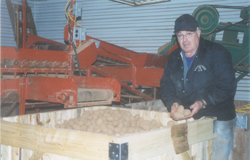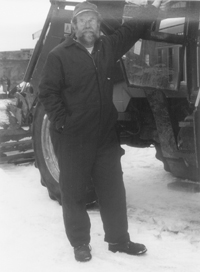
Features
Production
Research
P.E.I. farmers looking at alternative growing methods
looking at alternative growing methods
April 23, 2008 By Kathy Birt
There’s a movement afoot
in agriculture on P.E.I. “Island farmers are cutting back on all
chemicals and looking at alternatives,” said Susan MacKinnon, Reduced
Inputs Officer with the Prince Edward Island Department of Agriculture,
Fisheries, and Aquaculture. (PEIAFA)

|
| Fred Dollar of Winsloe, P.E.I., took on the organic challenge a few years ago and converted his 275 acre farm to organic with 50 of those acres producing organic potatoes. Susan MacKinnon, the reducing inputs officer with the P.E.I. agriculture department was instrumental in guiding Dollar through the various steps and stages. Photo by Kathy Birt |
There’s a movement afoot in agriculture on P.E.I. “Island farmers are cutting back on all chemicals and looking at alternatives,” said Susan MacKinnon, Reduced Inputs Officer with the Prince Edward Island Department of Agriculture, Fisheries, and Aquaculture. (PEIAFA)
And those alternatives can include include anything from beneficial insects to lobster compost. MacKinnon’s criteria as Reduced Inputs Officer is to work primarily with organic growers but she indicates that conventional farmers can use the information and technology being offered through the research and programs.
She offers as an example the work that is currently on-going at the Organic Agriculture Centre in Truro, Nova Scotia, which is affiliated with the Nova Scotia Agriculture College. “The centre has developed a number of online courses and is carrying out on-farm (chemical reduction) research in the Maritimes,” said MacKinnon.
One course of action being taken by the department was to seek registration for lower impact chemicals and, in conjunction with the organic industry in P.E.I. and New Brunswick, they were able to get an emergency registration for Entrust in 2004. “Some farmers, including organic, were able to use it in the control of the Colorado potato beetle. And efforts are being made to have the product registered in 2005 so all farmers can use it.”

Organic farmers like Reg Phelan of Morell and Fred Dollar of Winsloe would embrace any government action that will enhance the organic movement and offer long-term options for conventional
farmers.
Phelan, who lives on the farm where he was born, has a hundred acres of land, which he says has never been intensively chemically farmed. “Chemical intensive farming began to happen in the 60s and the organic movement really didn’t start to happen until the 1980s. It’s a pretty slow process,” said Phelan, a founding member of Sea Spray Co-operative, a group of organic growers who opt to work together. The co-operative started in the early 1990s on P.E.I. and is now operating Maritime-wide with between 12 and 15 members.
“It’s a single-desk selling concept,” he explained. “If one grower gets a contract, we share it with all the producers. Everybody gets an equal share of the market and everyone gets the same price (for their produce).”
He said the system, although small, is working. “We plan our crops together, look at the market and divide the acreage. If there is more volume needed of one crop, this is equally divided.”
 |
| It may seem like Reg Phelan of Morell, P.E.I., marches to a different drummer on his 100 acre organic farm. He and his wife Stella Shepherd are members of the Sea Spray Co-operative where crops and profits are grown and shared equally. Photo by Kathy Birt |
Phelan’s loyalty and unconventional ideas were instilled in his youth, where pride in the land took precedence over profits. His wife Stella Shepherd remarks that upon achieving his master’s degree in Atlantic Canada Studies from St. Mary’s University in Nova Scotia, her husband wrote his thesis on land-use by researching agriculture folklore. She points out that he went to the people rather than research libraries and archives. “He didn’t just write his thesis; he lives it,” she said.
And living it means nurturing the land with low-impact methods of controlling disease and insects, enabling Phelan to offer a variety of organic cole crops to the consumer through the co-op.
He said co-operative members used to grow potatoes in small amounts; some organic, some conventional. “This was before third-party certification.”
Certification came in 1996 for Phelan and he now grows about 10 acres of organic potatoes, adding there is only a total of about 30 acres grown within the co-op because there is just not the market for them right now.
With a glut of potatoes on the world market, the co-op members stay small and, in some cases, service a growing local market for organically grown cole crops.
“I start everything in the greenhouse, except potatoes,” noted Phelan, adding he produces lettuce, cabbage, broccoli, turnip, cauliflower, and Brussel sprouts. Although the co-operative supplies markets in Central Canada and the West Coast of the U.S., Phelan said it’s been his experience that local supermarkets are looking more toward mixed organic produce, “particularly Atlantic superstores.”
Phelan and Shepherd suggest that, in theory, growing organically is like swimming against the tide.
But MacKinnon is working towards altering the tide by encouraging all conventional farmers to consider organic. This ongoing work through her department may lead to increased numbers of organic farmers, and/or downscale chemical farming over the next 10 to 15 years.
Emphasizing again that all Island farmers are really looking at what they put on the land, MacKinnon said many are incorporating lobster compost, a product that promotes fertility. “It contains chitin, which builds up beneficial soil organisms and decreases the organisms that cause disease,” said MacKinnon.
Farmers are also looking at the better use of buffer zones, she added, and are also showing interest in new soil additions, including a compost tea made from manure and seaweed extract, which is being used by at least three farmers to control blight. “We had mixed results,” said Phelan.
Fred Dollar, an organic farmer from Winsloe used compost tea and agrees results were not as great as anticipated. “It’s not refined and was a problem to spray,” he said. “There might be a few nutrients in it that are useful. But it would work better if we could use it before we plant to promote healthier soil.”
Dollar grows 50 acres of organic potatoes and farms a total of 275 acres organically. He says he generally uses organic fertilizer and fungicide (for blight) with herbicide. “There is no off-farm nitrogen used (on our farm). We get that from other sources, such as liquid seaweed, or we plow down clover (to add nutrients to the soil.)”
Another method of adding nutrients to chemical-induced soil is called worm-castings or vermiculture. This involves adding red worms, or wigglers, to a commonly used compost, whereby the worms digest it and produce castings (excrement) that she said is “fairly fertile and high in nutrients.”
MacKinnon explained one of several projects carried out by Agriculture and Agri-Food Canada that could cut down on losses in cole crops involves the trichogramma wasp, which was introduced to several organic potato crops in P.E.I. MacKinnon points out that the wasp goes after any soft-bodied caterpillars and lays eggs in the larvae, which kills the offending caterpillar.
Historically, farmers depended upon beneficial insects and some newer methods of utilizing them are now being experimented with, MacKinnon said. This is where the practice of trenching comes in, where producers dig trenches around a field which are then lined with plastic. Some soil is put in the trench but not enough to allow insects, like the Colorado potato beetle, to climb out.
“Both organic and conventional farmers are using this method.”
Another practice among the inventory of ways and means to cut back on chemicals in P.E.I. is trap cropping.
“Farmers might plant collards around the perimeter of a cole crop that attracts similar pests (that might infiltrate the main crop). The insects land on the trap crop, leaving the main crop safe,” said MacKinnon, adding this allows farmers to spray the trap crops, thus reducing insect pressure on the main crop.
“The potato guys may not pick up on trap crops as quickly as vegetable growers, primarily because it requires more timely management (with potatoes).”
MacKinnon said aphids are a major problem for potato growers and to help control these insects, some growers are using a method of leaving a green area in combination with a strip of soil around the field perimeter. “This confuses the aphids and they stay in the green area.”
Mechanically, organic growers have begun purchasing weeders in recent years. “They’ve bought reigi weeders and finger weeders to control weeds in vegetable and grain crops and some have bought wick weeders,” said MacKinnon. “The wick weeders are adjustable and in some cases, where the canopy of the crop is lower than the weeds, the weeder just touches the weeds (but not the crop).”
MacKinnon points out that some conventional farmers are using GPS systems to actually help prevent overlap when applying chemicals. The P.E.I. ag department is offering programs in pesticide reduction and also lends financial assistance to farmers to buy the necessary equipment or technology to reduce the use of pesticides.
Print this page